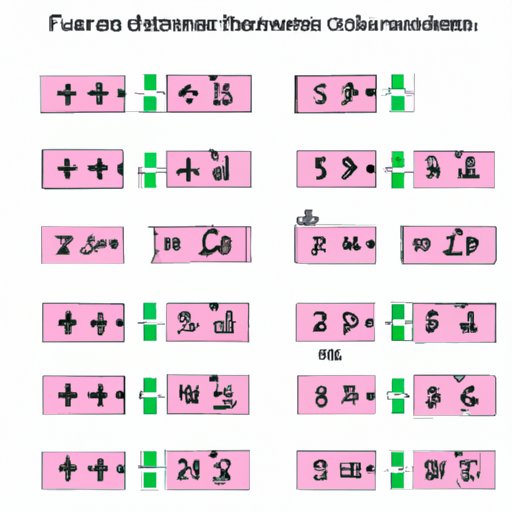
How to Reduce Fractions: A Step-by-Step Guide
If you remember your school years, you might recall those long math classes where fractions were taught, but how to reduce them was never explained. In this article, we will dive deeper into how you can reduce fractions and simplify them to their lowest possible values.
I. Introduction
A fraction is a numerical value that represents a part of a whole. It consists of a numerator and a denominator, separated by a horizontal line. The numerator is the value above the line, and the denominator is the value below the line. Reducing fractions is the process of dividing both the numerator and denominator by their greatest common factor (GCF) to simplify them to their lowest possible values.
Reducing fractions is an essential skill to learn in math class as it makes calculations easier and makes it easier to understand the relationship between numbers.
II. Common Misconceptions
There are many common misconceptions surrounding reducing fractions, and it’s crucial to debunk them before we move forward.
The most common misconception is that reducing a fraction changes its value or makes it smaller. This is not true. Reducing fractions only simplifies them to their lowest possible values while preserving their ratio.
III. Simplifying Fractions Step-by-Step
Simplifying fractions can be done in a few simple steps.
1. Find the greatest common factor (GCF) of the numerator and denominator.
2. Divide both the numerator and denominator by the GCF.
3. Simplify the fraction if possible.
Let’s use an example to enhance your understanding. Assume we have the fraction 12/16, and we want to reduce it to its simplest form.
1. Find the greatest common factor (GCF) of 12 and 16, which is 4.
2. Divide both the numerator and denominator by 4.
12/4 = 3
16/4 = 4
3. Simplify the fraction if possible, which gives us 3/4, the lowest possible value of the fraction.
IV. Common Methods of Simplifying Fractions
There are two primary methods of simplifying fractions; dividing by the Greatest Common Factor (GCF) and the Cross-cancelling technique.
A. Dividing by the Greatest Common Factor (GCF)
This method involves finding the GCF between the numerator and denominator and dividing both by that number.
Let’s use an example: simplify the fraction 24/32.
1. Find the greatest common factor of 24 and 32, which is 8.
2. Divide both the numerator and denominator by 8.
24/8=3
32/8=4
3. Simplify the fraction if possible, which gives us 3/4.
B. Cross-Cancelling Technique
The cross-cancelling technique involves canceling out a common factor between the numerator and the denominator before dividing.
Let’s use an example: simplify the fraction 16/24.
1. Identify a common factor between the numerator and denominator, which is 8.
2. Cross-cancel that number, which leaves us with 2/3.
3. Simplify the fraction if possible, which gives us 2/3, the lowest possible value of the fraction.
C. Advantages and Disadvantages of Each Method
Both methods are equally effective and lead to the same result. However, dividing by the GCF is a more straightforward and quicker approach. On the other hand, the cross-canceling technique is great for more complex fractions and can simplify them faster.
V. Exercises to Practice Reducing Fractions
Practice makes perfect! Try these exercises to master the art of reducing fractions.
Exercise 1: Simplify the fraction 36/48.
Exercise 2: Simplify the fraction 42/56.
Exercise 3: Simplify the fraction 60/84.
If you’re having trouble, don’t worry. You can find the answer key below.
VI. Real-life Applications of Reducing Fractions
Reducing fractions applies beyond the math classroom, and here are some examples of how.
A. Examples of How Reducing Fractions can be Useful in Practical Scenarios
Suppose you’re on a baking spree following a recipe. The recipe calls for 3/4 cups of sugar. You only have 1 1/2 cups of sugar. Using the reducing fractions concept, you can simplify 1 1/2 cups into 1 2/4 cups. You can then divide both numerator and denominator by the GCF, 2, to get the proper measurement, which is 3/4 cups of sugar.
B. Application in Day-to-day activities like shopping, cooking, or measuring things
A similar application applies when you want to mix paints to create a unique color. Suppose you have 2/3 cups of blue paint and 4/5 cups of red paint. Using the reducing fractions concept, you can simplify the fractions to 2/3 and 4/5. The lowest common denominator is 15, which is the product of 3 and 5. Multiply each numerator and denominator with the required number to get the units to be added in each color.
VII. Conclusion
In conclusion, reducing fractions is a crucial math skill that needs to be mastered. It simplifies fractions to their lowest possible values, making calculations much more comfortable. The article outlined how to reduce fractions in various ways, provided exercises to practice and apply the skill, and showed how they apply to practical scenarios.
Remember to practice the skill regularly, as it will provide you with more practical evidence of the usefulness of fractions in your everyday life.




